This is Part 3 of a 3-part trip report. Click below for Parts 1 and 2:
Culture shock? No way—not us!
Over the years, we’ve learned a lot about Korean culture through our Korean friends and students. (One of whom we consider to be family.)
Shopping at Korean grocery stores is a fun, frequent outing for us. We regularly enjoy (or should I say devour) Korean food. And on top of all that, M was even a K-drama fan for a while!
Due to all this, we landed in Korea thinking we knew what to expect. Instead, we started our visit with an unexpected case of culture shock.
The shock sets in
Seoul is a modern, developed city. It’s much like any big city with malls, Starbucks, and McDonald’s everywhere. So what exactly was so shocking?
A significant factor was the language barrier—it was bigger than we’d anticipated. We were also caught off-guard by the aggressive vendors and people spitting in public* (even INSIDE train stations!) And, without the use of good old Google Maps, we felt a little lost.
*We’re not that sheltered! We’ve encountered plenty of aggressive vendors and public spitting in our travels (and even in Vancouver!) It was just unexpected to face that in modern, developed Korea—which we expected to be very similar to Japan. (If you know Japan, you know the train station floors are just about clean enough to eat off of!)
A mindset shift
We always try to be open-minded, especially when travelling. So after the initial shock, we took a deep breath, let go of our expectations, and went with the flow.
This mindset shift helped move us from shock to curiosity. We relaxed, and took each moment for what it was: a new and different experience to learn from. Instead of resisting, we began to embrace the things that made Korea different and unique.
An ounce of prevention
I did extensive research on travelling in Japan before our trip there last year. But I didn’t have time to do the same for our Korea trip. Though we recovered from our culture shock, I could’ve prevented it if I’d taken the time to learn a little more than I did.
That’s why I decided to make notes about things we learned as we travelled in Korea. I hope my tips help to make your travels in Korea a little easier (and a lot less shocking)!
Disclosure: The product recommendation(s) in this post include Amazon links. As an Amazon Associate I earn from qualifying purchases—at no extra cost to you. I only recommend products which I truly believe in, and encourage you to find free or second-hand options when possible.
22 tips for travelling in Korea
1. Call 1330 for help
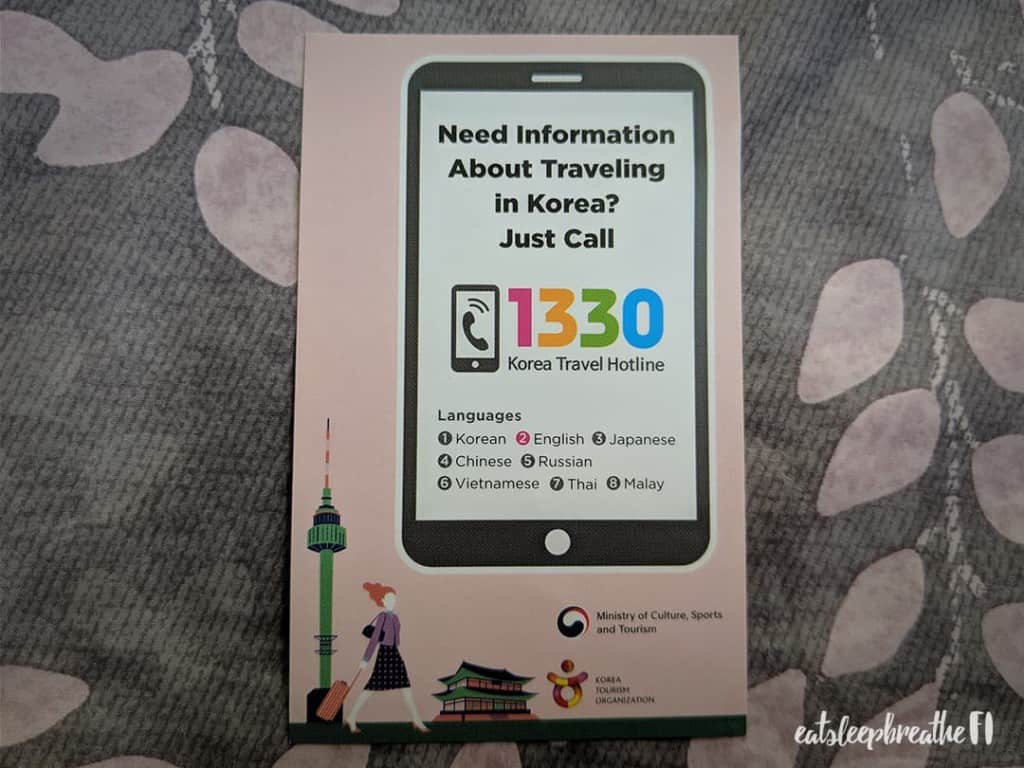
The 1330 Korea Travel Hotline, operated by Korea Tourism Organization (KTO), is a one-stop helpline available as a public service for local and international travellers. For any inquiries or complaints relating to Korean tourism, either beforehand or during your stay in Korea, you can seek assistance here as well.
We didn’t realize how helpful the 1330 hotline would be until Kid 2 left his backpack at a bakery. We called the bakery to ask if they’d found the backpack, but no one there spoke English!
We hung up and had a moment of panic, then remembered we could call the 1330 hotline for help. We were connected with a friendly staffer who spoke perfect English. She called the bakery and explained the situation in Korean while I waited on the line.
They confirmed that they had the backpack, and would hold it for us until we could swing by on our way home. Phew!
A situation like this could have ruined our day, but was instead a minor hiccup—all thanks to the 1330 hotline. We’re so grateful for this amazing service.
2. Get the Naver Map app

Due to security concerns, the South Korean government doesn’t allow Google Maps to provide navigation. Instead, we used Naver Map to get around. (We also tried Kakao Map, but found Naver to be more English-friendly.)
Here are some tips for using Naver:
- Naver is pronounced NAY-ver (rhymes with saver).
- The blue location dot is often sluggish (and at times completely inaccurate). Sometimes moving your phone in a figure-eight motion helps to re-calibrate it.
- Naver is great for navigating into/out of train stations. Zoom in to see the station exit numbers so you can plan ahead and use the correct exit for your destination. (The yellow dots in the screen cap above show the exit numbers for Jonggak Station.)
- After you plan a route, tap on the stations in the directions list to see more details about that station. (For example: the stations before/after; how many minutes until you arrive at the next station).
- Naver has somewhat limited search functions when typing in English. You may have to try different search terms, type one word as two, or two words as one.
- Don’t even bother typing addresses in English! They never work. The best way to navigate to a specific address is to get the address in Korean, then paste that into Naver.
- You can pin (or more accurately, star) favourite locations. Then you can easily see where attractions are located, and plan to see a cluster of them together.
- Starring favourites also saves you from repeatedly having to search for frequently-visited locations.
3. Transportation cards
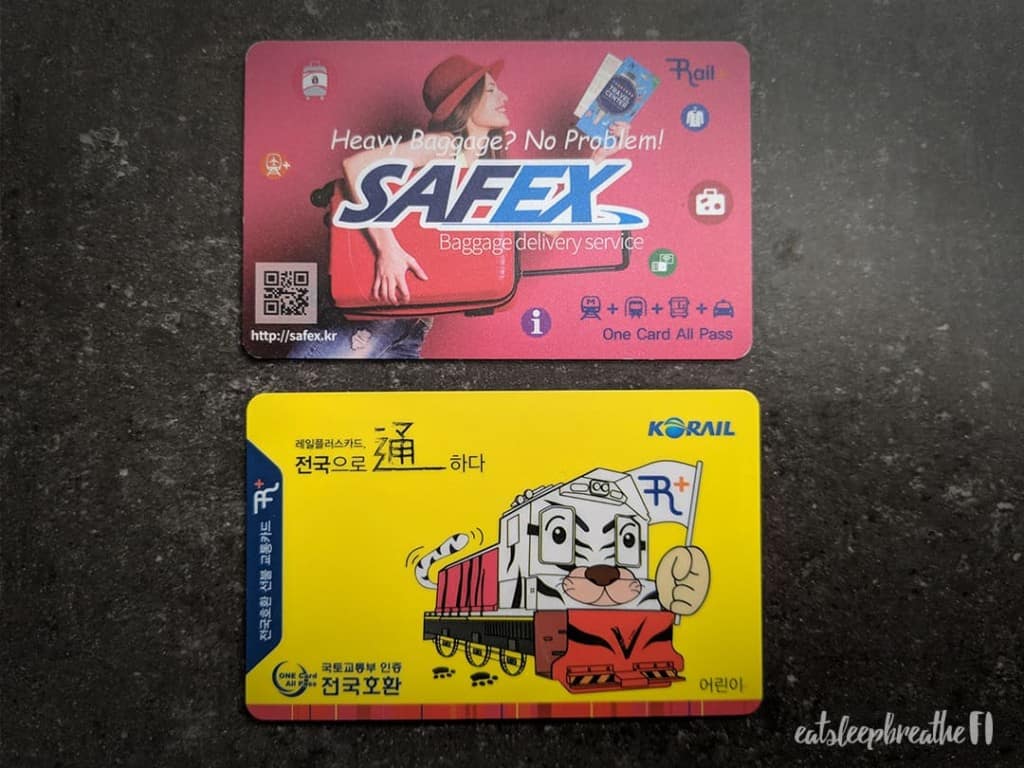
Upon landing in Korea, get a transportation card for each member of your travelling party. It’s cheaper and way more convenient than paying for single fares.
Here are more tips for using Korean transportation cards:
- No, you can’t share transportation cards! Each person must have their own.
- Children under 6 travel free; ages 6–12 get the child rate; ages 13–18 get the youth rate. You need to show passports to buy child and youth transportation cards.
- There are a few Korean transportation cards. Railplus and T-money are the most popular. Both work the same way on transit, and both can be refilled at subway station ticket machines.
- You can also refill at convenience stores. (But you don’t use a machine—the cashier does it for you at the till.) We refilled our Railplus cards at Storyway, but couldn’t at CU. I believe T-money cards can be refilled at any convenience store.
- Each person should keep their own transportation card in an easily-accessible pocket. You don’t want to be fumbling for your card at the gate!
- If your kids don’t have a secure, easy-to-access pocket, it’s best if you hold their cards for them. Then make it a routine to pause in a quiet spot near the gates so you can hand their cards to them. (Then do the same as you collect their cards after you tap through.)
- Our Railplus cards worked in Seoul, Busan, and Jeju Island. I believe all Korean transportation cards should work anywhere in Korea.
4. Getting around train and subway stations
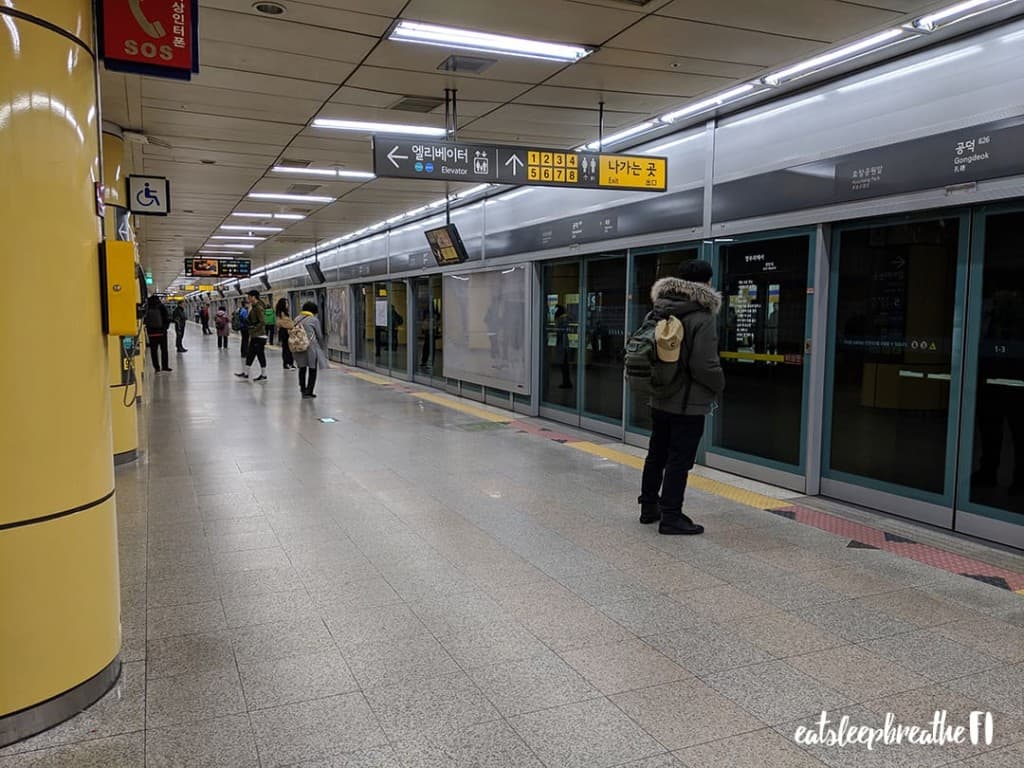
Save yourself time and hassle with these train/subway station tips:
- Check which direction you need to go, then confirm which train platform will take you there. Do all this before you tap your card and go down to the tracks! You won’t get a refund if you make a mistake and have to tap out to get to the other track. (I’ve since learned there’s a better way to handle this!)
- If you need assistance in a subway station, look for the wheelchair gate. There should be a help button on or near the gate that you can press to speak with an attendant.
- If you get an error message when tapping in, it’s most likely because your card has insufficient funds. Try checking the balance and refilling before you call for help! (We may have had personal experience with this…
)
- At your arrival station, look for navigational signs as you exit the train. They’ll point you to specific exit numbers and other subway lines. Instead of blindly following the crowd (like we always did in Japan!) follow these navigational signs to quickly and easily get where you need to go.
- If you’re transferring lines, make sure you don’t tap out and exit. There should always be a way to connect to another line within the station without tapping out. This saves you from paying for a whole new fare.
5. Bring travel adapters

This was our own dumb mistake! We assumed Korea would be like Japan and figured we’d have no problems charging our electronics using our North American plugs. We discovered (after arriving) that Korea uses the Type F plugs that are commonly used in Europe.
Only half our Airbnbs had adapters, and one hotel we stayed in had no adapters. Luckily, we’d brought one of our own just in case.
Combined with the multi-plug outlets at the hotels and USB cables at the Airbnbs, that was just enough to get by. It wasn’t easy charging our eight devices and one electric toothbrush every day, but we made it work!
Don’t make our mistake! Bring an adapter with multiple USB ports.
6. Korean bathrooms can be very wet places

Korean bathrooms often don’t have shower enclosures. This means the entire bathroom gets soaked when showering. (This is also the norm in many European countries.)
The bathrooms are designed this way, with large floor drains for the water to run into. We stayed in one Airbnb with this style of bathroom, but we just couldn’t get used to it! (Maybe we were doing it all wrong?)
It was challenging to find enough dry spots to leave our clothes and toiletries. And we also had a hard time trying not to get the toilet seat wet—even with the lid down.
If you prefer to keep your shower water contained, there are Airbnbs with enclosed showers. But this isn’t a feature that’s mentioned in the descriptions. So make sure you look through the photos and/or contact the host to confirm.
7. Bath towels? Not always!
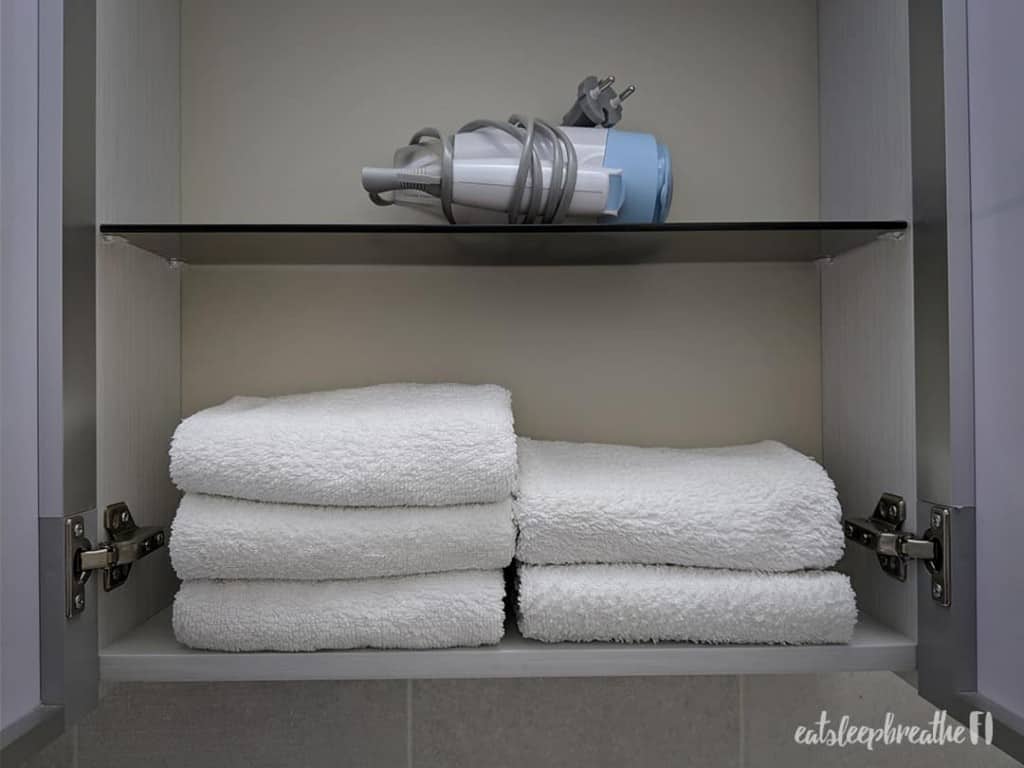
Of the five Korean Airbnbs we stayed in, only two offered bath towels. The rest? Just hand towels! This is likely due to the fact that most (or all?) Korean homes don’t have dryers. (This was also the case in Japan.)
At first, I had no idea how we could deal with using only hand towels to dry off after our showers. #firstworldproblems
But after my first experience, I realized that maybe we’re the ones who have it all wrong. A single hand towel was more than enough to dry off with and soak up a lot of the water in my hair.
In fact, when I was done, the towel still had dry spots and wasn’t even overly damp! The only minor issue was the towel was too small to wrap all my long hair into.
This eye-opening experience got me thinking… could I make do with a hand towel at home too? (It’d likely only be me who makes the switch—M and the kids will definitely fight me on this! )
8. Public washroom surprises

We encountered some surprises in the public washrooms in Korea:
- No toilet paper: Shocking, but true—some public washrooms have no toilet paper! Be sure to keep some in your pocket at all times.
- No soap or only bar soap: M didn’t think the shared bar soap was a big deal, but it totally grossed me out! Thank goodness for my purse-sized hand sanitizer!
- No paper towels: Some washrooms don’t have paper towels or hand dryers. So carry a handkerchief with you, or resort to giving your hands a quick swipe on your jeans.
- Squat toilets: While rare, some public washrooms still have squat toilets! In my experience, you’ll never come across a washroom with only squat toilets. But be prepared to encounter one or two of these toilets in your Korean travels!
9. The ‘no toilet paper in the toilet’ myth

There’s an old, but stubborn belief in Korea that toilet paper clogs toilets. Because of this, you may came across toilet stalls with a bin beside the toilet. Sometimes, this bin will be overflowing… with soiled toilet paper.
(Thankfully, everyone’s very discreet and wraps the grossness in multiple layers of clean TP. But that’s not exactly great for the environment.)
Our first Airbnb even had a sign taped to the toilet telling us not to dispose of any TP in the toilet. We tried it for one day… got too grossed out, then looked it up. This is when we learned it’s an old myth that really should be busted once and for all.
10. The tap water myth
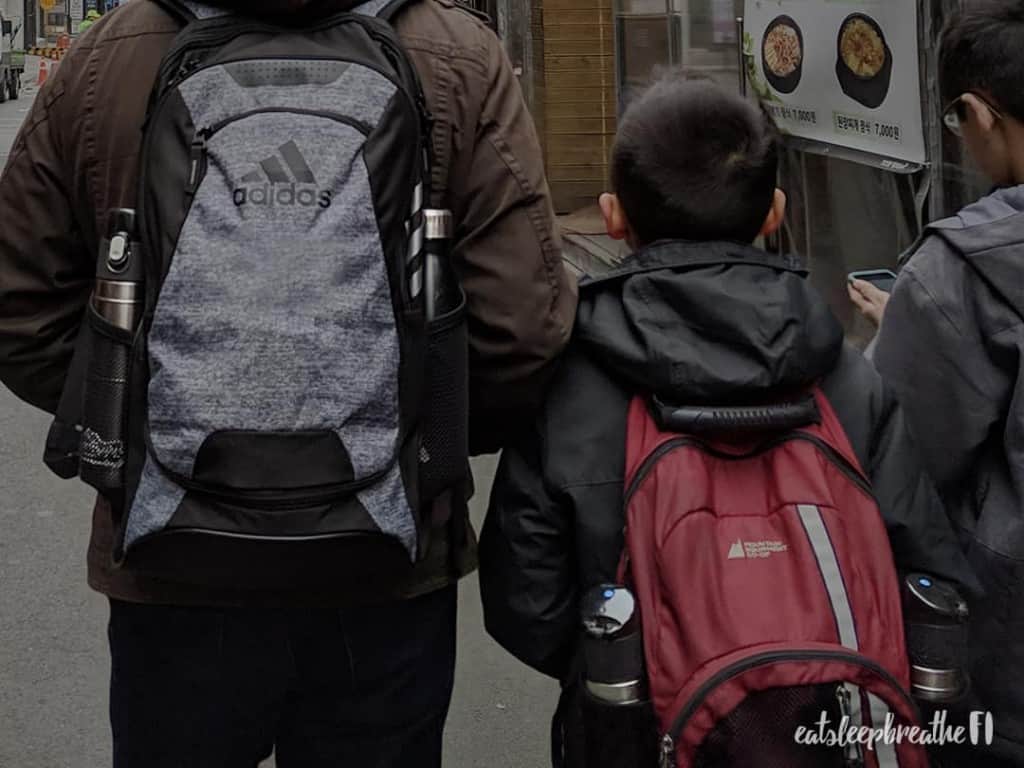
Our Korean students are often surprised that we drink unfiltered tap water at our house. They tell us that Korean water is unsafe. One student even told us the tap water in Korea is sometimes black! (Totally untrue.)
Upon arriving, I did some research and discovered that the tap water is in fact very clean and safe to drink. It’s another Korean myth that should be busted. (After all—drinking tap water is better for the earth, and often better for us than bottled water.)
We drank unfiltered tap water in Korea with no issues (with our health or the taste). So feel free to do the same!
You’ll notice in our photos that we carry our trusty THERMOS water bottles everywhere with us. They always get packed for our trips! Filling them with free tap water saves money and is way healthier than store-bought drinks.
11. Korea is very credit card friendly
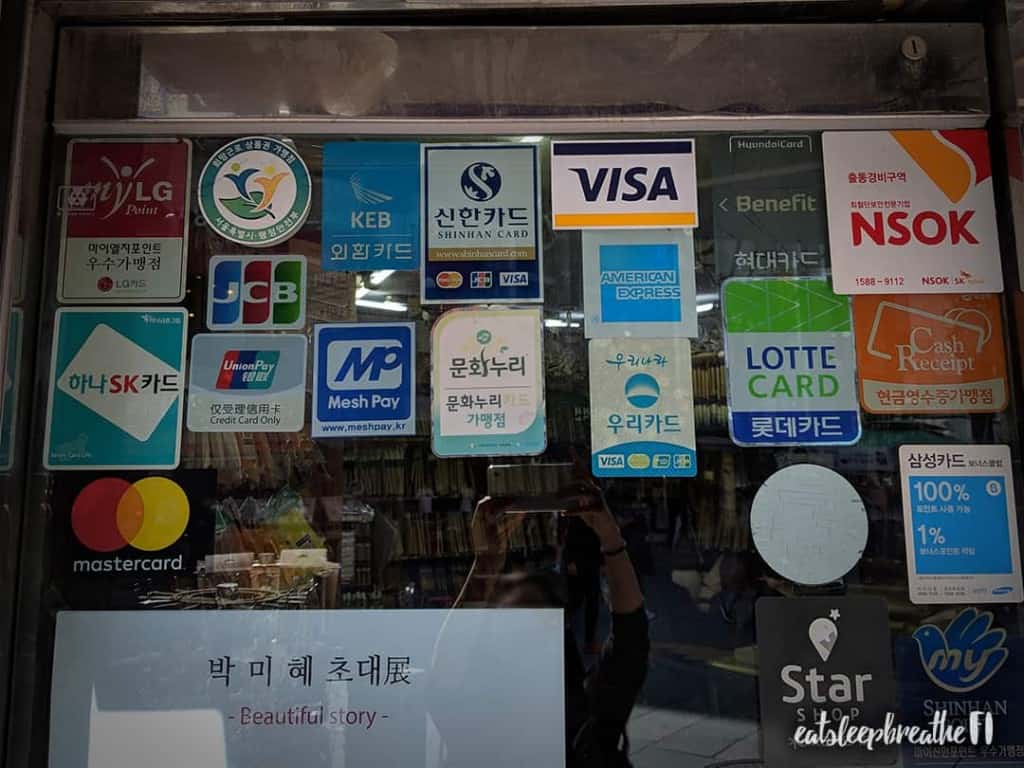
On our trip, the only places where credit cards weren’t accepted were:
- Transit ticket/card refill machines.
- Food stalls.
- Some taxis.
- Some small shops (they’ll add an upcharge if you use your credit card, or request that you pay in cash.)
Almost everywhere else, we were able to pay with credit cards. We used our Rogers World Elite Mastercard* throughout our trip, and had zero acceptance issues. (Unlike in Japan, where our card was rejected by some card readers.)
*I no longer recommend using this card outside of Canada and the US—it stopped offering cashback on foreign currency transactions (which offset the foreign exchange fee). Instead, consider the Home Trust Preferred Visa, which charges no annual or foreign exchange fee.
12. Exchanging for Korean won cheaply
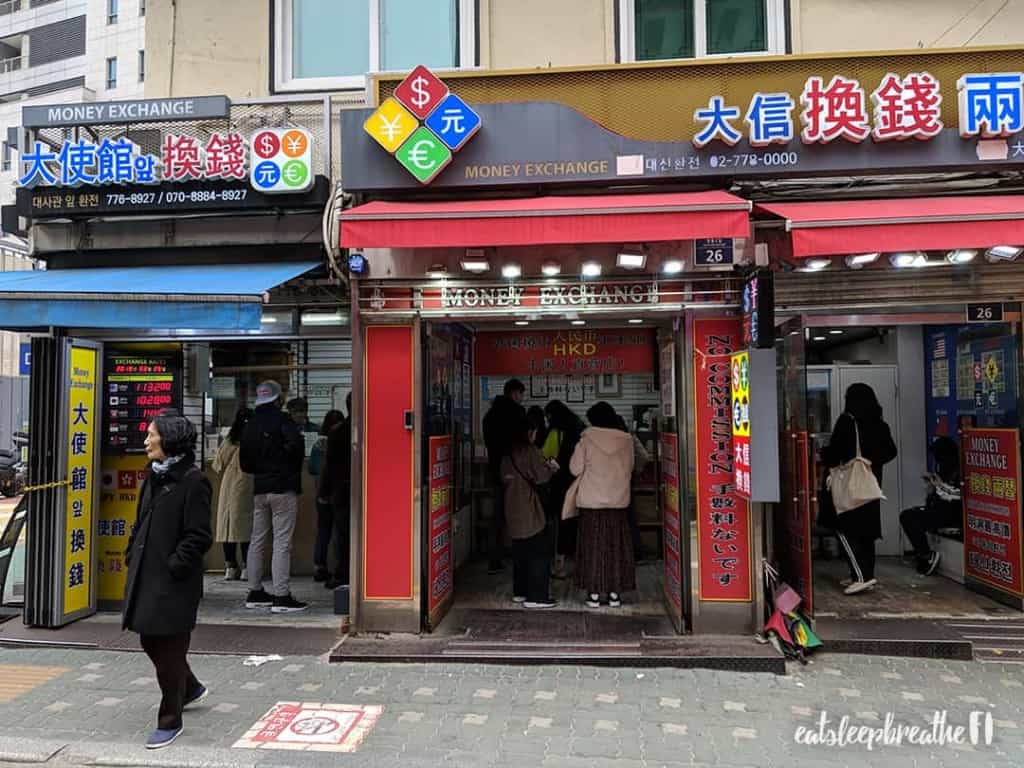
Despite the wide acceptance of credit cards in Korea, you’ll still need some cash. (Plan for 10–15% of your purchases to be in cash.)
Based on my research, the cheapest way to access South Korean won (KRW) is to bring US dollars to exchange in Korea. Here are the two currency exchange places we used and recommend:
- Daesin Currency Exchange: 26 Myeongdong 2-gil. (Recommended on Trip Advisor forms.)
- KB Bank Currency Exchange Centre (in the basement of Seoul Station): 378 Cheongpa-ro Yongsan-gu Seoul.
Both charged no commission fee, and a low 0.99–1.25% spread on the conversion. This is far cheaper than most of the other options I researched:
- US and Canadian banks: 4–5%.
- Korean ATMs: 2–5%. (Depends on what your bank and the ATM machine charge for foreign currency conversion. You also have to find ATMs that work with foreign bank cards.)
- Canadian currency exchange: 2–3%.
- Korean airport currency exchange: 2–3%.
- Korean banks: 1–2%.
Some notes
- We have a regular source of USD from selling M’s company stock options. USD’s the most popular currency to exchange with, but I think you’ll still get a good rate with other major currencies. (I didn’t confirm this, so be sure to check before you go.)
- It’s a good idea to land in Korea with some KRW. (You’ll need it to pay for train tickets and transportation cards.) 100,000 to 200,000 KRW (about $90–$175 USD) should be enough to last you a couple of days.
- For our initial ‘float’ of 200,000 KRW, we were fortunate to have been able to buy it from M’s uncle (who recently returned from a trip to Korea). But if we didn’t have this option, I would’ve exchanged for some KRW at a currency exchange at home.
- Some people on Trip Advisor mention little old ladies in Myeongdong who sell KRW for 0.5–1.5%. I think the ladies in the picture below may have been doing just this, but I’m not sure. If you want to give them a try, I came across them a little ways in from Gate 3 of Namdaemun Market.
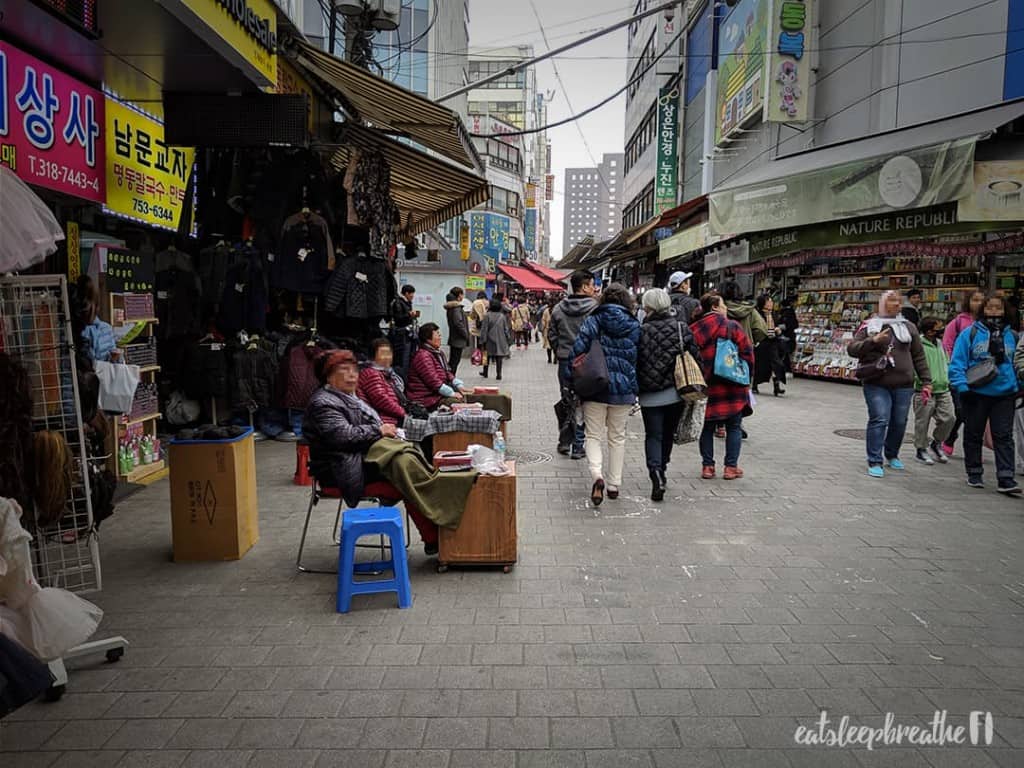
13. Free phone charging
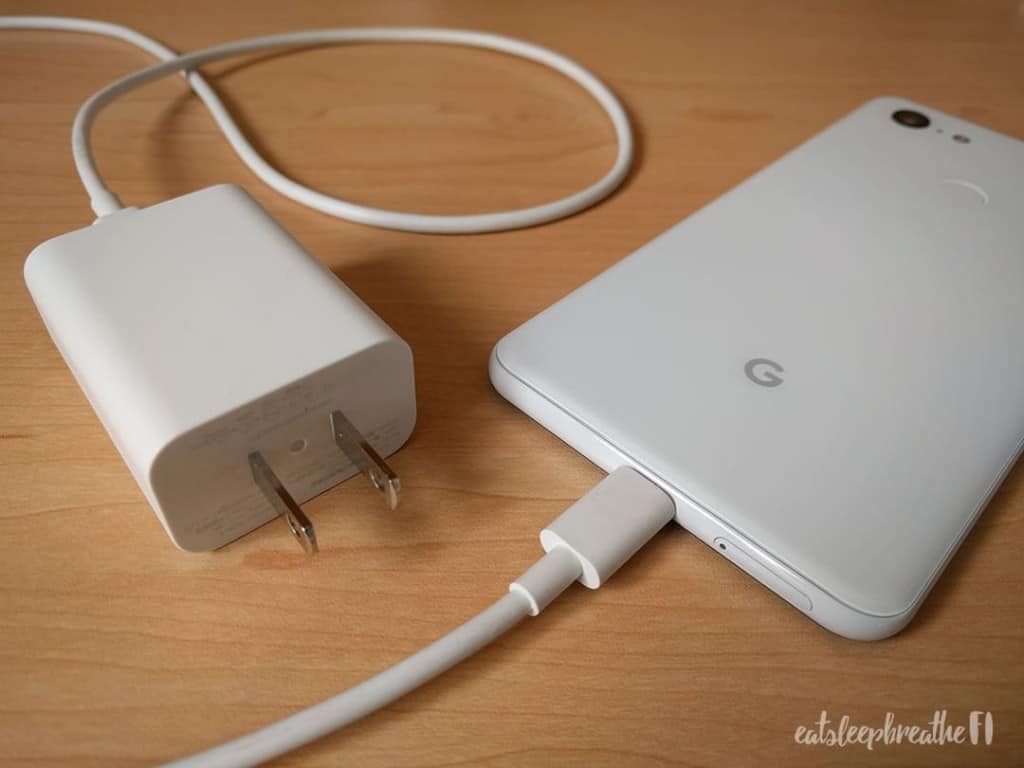
Did you know? You can ask for your phone to be charged for free at any restaurant in Korea! We’ve been told that all restaurants have Android chargers, but some don’t have iPhone chargers. (Android phones are used by everyone, but iPhones are mostly used by the younger crowd.)
I’ve since learned there are lots of other places to charge your phone.
14. Unlimited side dishes

Korean meals always come with small side dishes, aka banchan. They’re complimentary—as are the refills. Banchan are yummy, numerous, and varied. They include things like kimchee, dried fish, seaweed, salads, soups, noodles, and rice.
Banchan could be a meal on their own! (So keep this in mind when ordering.) While you shouldn’t take advantage and plan to fill up on banchan, we often found a lot of it went to waste (even without asking for refills). This is because we didn’t take banchan into account when ordering our main dishes.
Also note that wait staff will often (unasked) replace an empty banchan dish with a full one. So if you don’t want more banchan, make sure you don’t empty your banchan dishes until the end of your meal!
15. No doggy bags
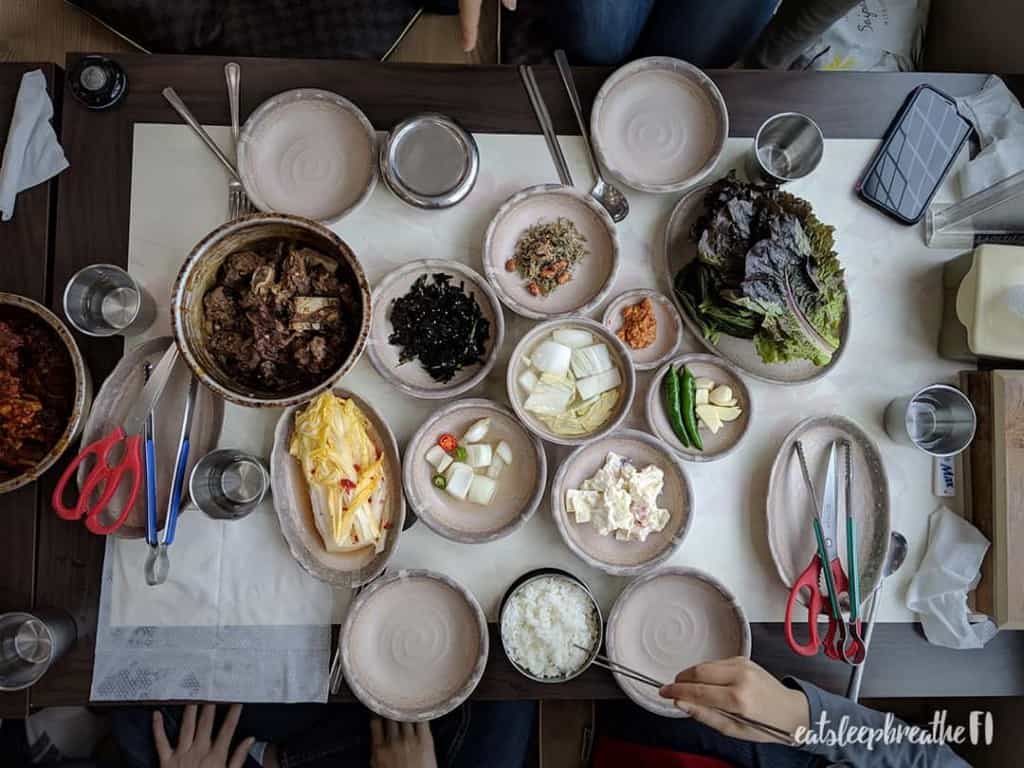
Portion sizes are quite generous in Korea, and we often forgot to take into account the free banchan. So for the first few days, we always ended up with a lot of uneaten food at the end of our meals.
We’re so used to doggy bags in North America that we assumed we’d be able to take leftovers home to enjoy later. This isn’t the case in Korea. (It was horrifying for us to let so much good, delicious food go to waste!)
We quickly learned to order less than what we thought we could eat. This took our food wastage down to a minimal amount, and prevented us from crying over all that uneaten food!
16. Taxis

Unlike Vancouver and Japan, taxis in Korea are affordable and plentiful! While public transit is usually the best option, taxis can sometimes be cheaper.
Tip: We never tried the Kakao T app, but you can apparently use it to hail a cab. It can also help you to figure out the approximate fare for your trip.
17. Kakao Talk

To communicate with Korean friends, get the Kakao Talk messaging app. It’s like Whatsapp or Facebook Messenger, and is the most popular messaging app in Korea.
18. Bring your own garbage bag

This is especially important when eating in the many traditional markets in Korea. It’s very rare to find garbage/recycling bins in these markets. This means you’ll quickly have your hands full of food wrappers until you leave the market!
Don’t make our mistake—plan ahead by bringing a plastic bag to hold your garbage until you can find a place to dump it.
19. Need a garbage/recycling bin, or clean washroom? Try train stations and parks!

If you can’t find a garbage or recycling bin for your trash, or are in need of a clean washroom—look for the nearest train station or park.
If you come across a train station washroom that’s only accessible after the fare gates, try to find the station master/info desk. You can ask them to let you through the gates without having to pay the fare.
20. Wet wipes are your friends
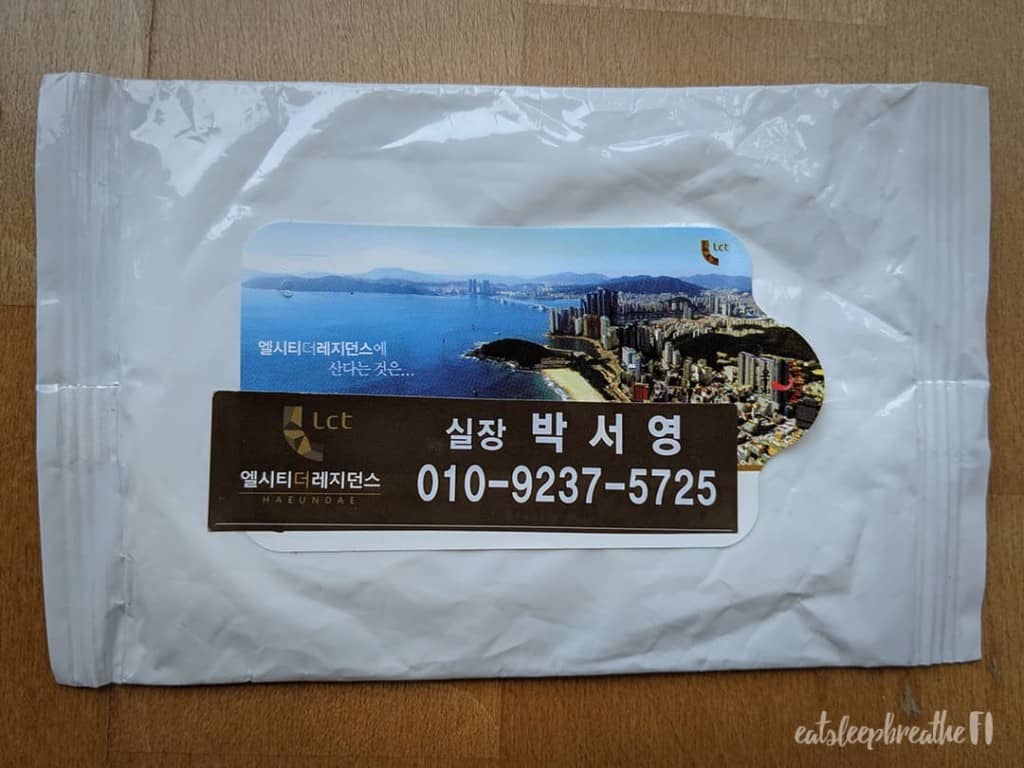
I try to avoid using wet wipes at home because they’re disposable and made of plastic. But they’re kind of a necessity when you’re eating your way through Korea!
Most Korean foods contain some sugar… and sugar is sticky. So keep a small pack of wet wipes on you at all times. (Or bring a handkerchief or cloth that you can wet with water from your bottle.)
I could’ve used some wet wipes when I ate my first hotteok. I had no idea that the hot, sticky filling can gush out and run all over the place. I caused ‘Hotteok Disaster 2019’, with sticky syrup all over my hair and jacket! #canttakemeanywhere
Our kids didn’t do much better and got the stickiness all over their hands and face. We only had tissues to clean up the disaster—and it was only the beginning of our long day out.
So carry those wet wipes!
21. Big grocery stores close on the 2nd and 4th Sundays of the month
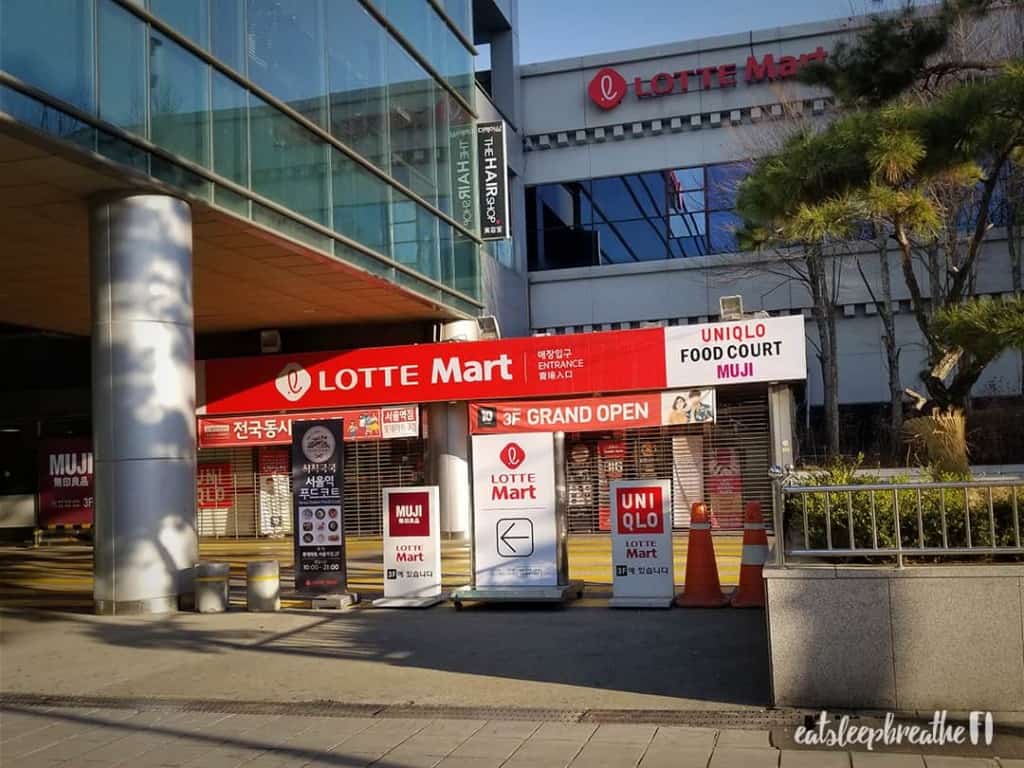
Keep in mind that large grocery stores close on the 2nd and 4th Sundays each month. (Apparently, the government mandated this in an effort to help small retailers.) Some stores vary from this schedule, so be sure to check before you visit.
If you can’t wait for your favourite store to reopen, you can also buy groceries at:
- Small neighbourhood grocery stores.
- Convenience stores.
- Department stores (like Lotte Department Store or Shinsegae—but their groceries can be very pricey!)
22. Korean ajummas
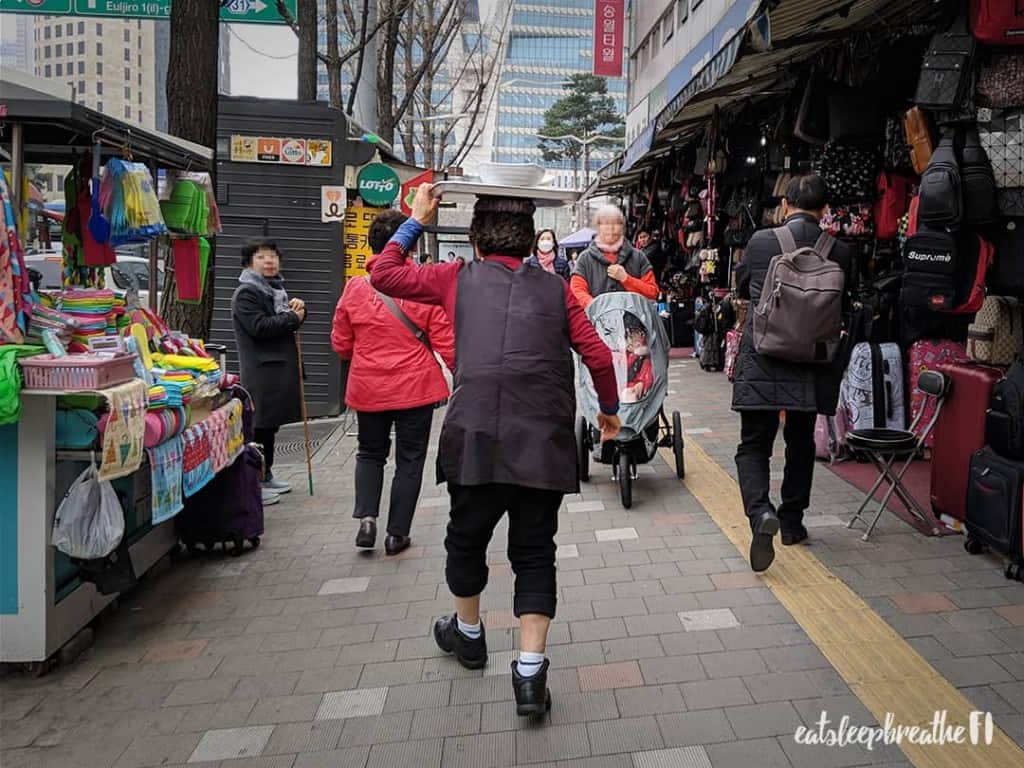
This isn’t actually a tip—more of a fun little anecdote.
Technically, the word ajumma refers to a married woman (making myself one by that definition), but nowadays nobody under the age of 70 seem to find the word very flattering. Therefore, the meaning of the word has gradually changed to mean a feisty elderly lady, who may often be very opinionated, thrifty, and, quite often, seen prancing the streets of Seoul sporting an ill-fitting perm over a wide sun protecting hat with floral pants to complete the look. Both of which are obviously universally flattering!
Ajummas seem to run the entire country and are a beloved part of Korean culture. They frequently hand-feed people (this happened to me at Lotte Mart). And they’ll often chatter away at you in Korean, unfazed by the fact that you don’t understand a word they’re saying!
We had several funny and heartwarming encounters with ajummas on our trip. But my favourite ajumma experience was at a hotteok stand. We hadn’t yet come across the hotteoks being made at this stand. They were green and coated with a brown sauce.
Intrigued, we tried to get a closer look. We hovered, unsure if we should order one or not. An ajumma was eating one of these hotteok and chatting with the owner of the stand (another ajumma).
When she noticed we weren’t sure about the hotteok, she started explaining things to us in Korean. Then she held her hotteok up to my mouth, offering me (a complete stranger) a bite!
I laughed, thanked her, and declined the sample then ordered our own. We’d thought she’d added the brown sauce to her hotteok, so we attempted to slather on the sauce that was on the counter. Both ajummas quickly saved us from our faux pas and waved us away from the sauce.
We realized that the brown sauce we saw on the hotteok was just the melted brown sugar filling oozing out. The sauce we tried to slather on was meant for fish cakes. Yikes! Good thing the ajummas stopped us from using it.
This hotteok turned out to be AH-MA-ZING! The dough had chives in it and was slightly savoury. The brown sugar filling was crunchy and gooey. Combined, it was heavenly. And the experience was even more memorable because of these funny ajummas.
They waved and smiled at us as we walked away, but we’re sure they were shaking their heads over our cluelessness!
TL;DR
Korea is an amazing, fascinating country. There’s a lot to love about it, but it’s not always the most tourist-friendly. Get more prepared than us by doing a bit of research and reading this list of tips.
To read all about what we saw, did, and ate in Korea, check out:
What about you?
Have you travelled to Korea? Got any tips or funny stories? Share in the comments below!
Support this blog
If you liked this article and want more content like this, please support this blog by sharing it! Not only does it help spread the FIRE, but it lets me know what content you find most useful. (Which encourages me to write more of it!)
You can also support this blog by visiting my recommendations page and purchasing through the links. Note that not every link is an affiliate link—some are just favourite products and services that I want to share. 🙂
As always, however you show your support for this blog—THANK YOU!


 )
)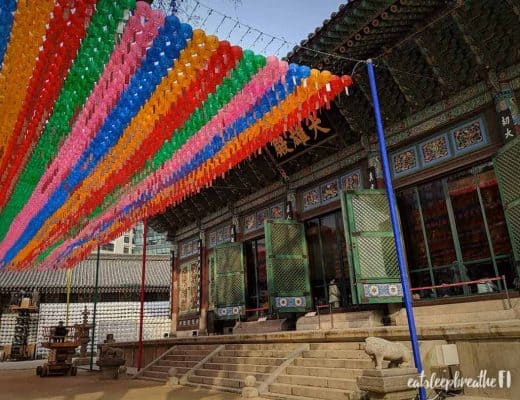
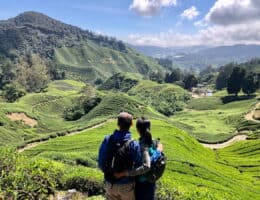

4 Comments
Lily
April 16, 2019 at 2:59 amTHERE ARE NO TO-GO BAGS??? Can you bring your own container??? Wait, wait, wait, is that the norm? How??! 95 out of 100 meals we eat out, I end up taking food home. They sell more food, I don’t have to crawl out of my cave later. Win-win! Korea doesn’t have this?? But it’s so basic!!
Is the internet there that super fast? 😀
Chrissy
April 16, 2019 at 3:47 pmOne restaurant we went to had containers for takeout/deliveries, and they reluctantly gave some to us for our leftovers. A different restaurant had no containers and treated us like we were crazy to even ask!
Our student Min told us it’s not normal to take leftovers home in Korea. It was the same in Japan, and also in Switzerland when we visited many years ago.
It seems we in North America are the weirdos! It totally doesn’t make sense to me because you’re right—it’s a win-win. It’s unfortunate—it’s so bad for the wallet and the environment to throw out good food. 🙁
(The internet wasn’t noticeably fast, but it was never slow! It’s also, apparently, super-cheap compared to Canada. )
Joe
April 22, 2019 at 8:29 amGreat write up. Nice job. I didn’t know you can drink tap water in Korea. I probably wouldn’t chance it, though. A vacation is short and I don’t want to spend any time at the hospital. 🙂
I visited Seoul once for about 8 hours. I had a long stopover and went to check it out. It was fun, but it was too short. Next time we’ll spend at least a week there.
ps. I fixed my email sign up form. Can you try and let me know? Thanks!
Chrissy
April 22, 2019 at 8:43 amThanks for the comment Joe. You’re right that it’s not always wise to take the chance. It would’ve ruined our trip if we got sick! Bottled water was very cheap in Korea, so it would’ve been a good option if we wanted to be cautious.
PS I just tried your signup form and it worked! Thanks for fixing it. 🙂